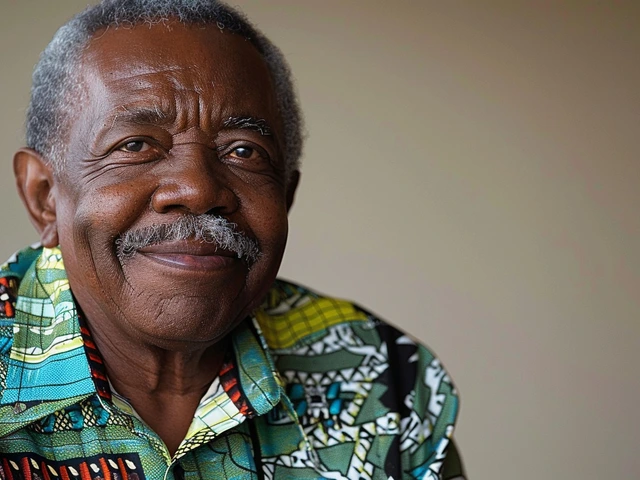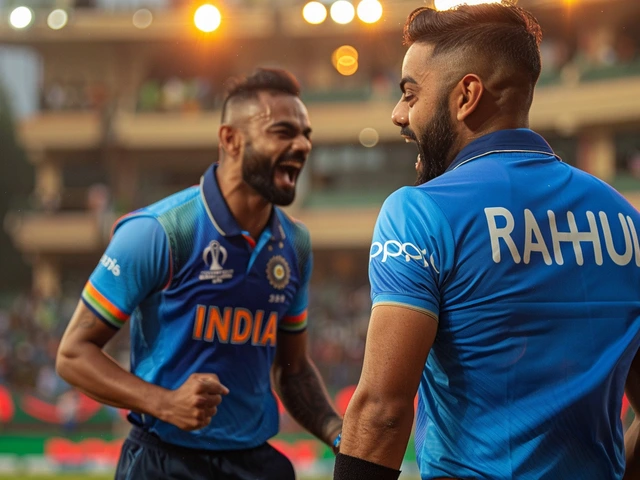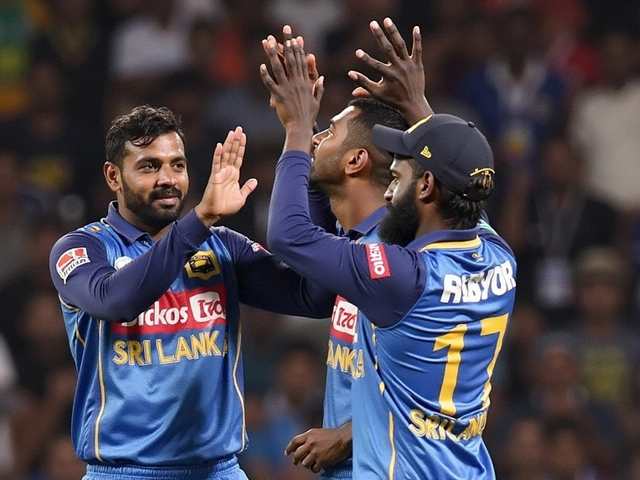Sri Lanka and West Indies Face Off in Crucial 3rd ODI Match at Pallekele: Live Updates and Analysis

Sri Lanka vs West Indies: The Pallekele Showdown
The cricketing world developed a hawk-eyed interest on October 26, 2024, as Sri Lanka and the West Indies squared off in the third and final One Day International (ODI) at Pallekele cricket stadium. With West Indies already having conceded the series in thrilling but disappointing fashion, the team was on a quest to restore some dignity and end the series with a note of positivity. Enthusiasts and analysts alike looked forward to anticipating strategic shifts that the teams might employ, particularly the West Indies, who found themselves on the back foot early in the series.
Throwing the first curveball, the West Indies won the toss and made a calculated decision to bowl first, an attempt to capitalize on potentially beneficial morning conditions. It was a move that spoke volumes about their updated strategy and intent to seize control right from the onset of the match. Sri Lanka, however, came in with their usual resilience, ready to face the ball with their balanced squad, despite missing key players. Crucially, Pathum Nissanka found himself replacing Nishan Madushka, adding a potential element of unpredictability to Sri Lanka's top order.
The Teams: A Closer Look at the Line-ups
Let’s delve into the team sheets, both marked with significant changes that set the stage for an intriguing encounter. For the hosts, Sri Lanka, the line-up featured a mix of promising young talents and seasoned players holding the fort. Pathum Nissanka was slated to open alongside Avishka Fernando, with Kusal Mendis wielding the wicket-keeping gloves, offering a blend of aggression and stability. Sadeera Samarawickrama, Charith Asalanka who also donned the captaincy mantle, Janith Liyanage, Kamindu Mendis, and spin wizard Wanindu Hasaranga formed a strong middle order. The bowling department boasted of Asitha Fernando and the powerful Dilshan Madushanka, who replaced Dunith Wellalage.
Meanwhile, the visiting West Indies team appeared dynamic and primed for a strong comeback. Under the captaincy of Shai Hope, who also assumed the wicket-keeping duties, the batting front was to be opened by the explosive Brandon King. The team underlined its strategic depth by handing a debut cap to Jewel Andrew, who replaced Romario Shepherd, while the veteran Evin Lewis filled in for Alick Athanaze. The adaptable Matthew Forde came in for Hayden Walsh, while Keacy Carty, Sherfane Rutherford, Gudakesh Motie, Roston Chase, and pace spearhead Alzarri Joseph completed the ensemble.
The Match Begins: A Battle of Wits and Skills
The conduct of the match saw both the teams implementing measured steps, both strategic and spontaneous. Sri Lanka's openers set the tone with a cautious yet fluent start, momentarily thwarted by the probing lengths and disciplined aggression delivered by the West Indies bowlers. The ball moved and seamed, testing the technique and patience of the Sri Lankan batsmen under swinging conditions. It's during these initial overs that the role of players like Kusal Mendis and Charith Asalanka became pivotal, helping build a foundation albeit conservative, for an imposing total in upcoming phases of the match.
Skills were being flexed on both sides as the game advanced. Audiences and expert panels watched closely as Shai Hope made methodical rotational changes in the bowling lineup, ensuring diversified pressure continuously applied on the Sri Lankan batsmen. Yet, Wanindu Hasaranga's all-round abilities surfaced brilliantly as he engaged both with bat and ideas to safely steer the innings past potential threats posed by fierce counterparts on the field.
The Strategic Finals
With the match entered into the more tactical middle overs, the compelling patience turned into a more assertive spectacle. Both the strategists are seen pulling off tricks and contingencies to leverage any evolving advantage. The West Indies struck crucial blows in key phases with Alzarri Joseph and Gudakesh Motie's decisive bowling maneuvers. The Lankan side answered with controlled aggression, ensuring boundary hits in regular intervals which kept the innings going and the scoreboard ticking without pressure pulling them down in this thrilling face-off.
The latter part of the match witnessed both teams’ battling bravely with strategic acumen, anticipating each other's next move. The field placements reflected the testing conditions figuring the best possible defenses and offenses shifting with calculated swiftness. Every boundary, every wicket seemed to speak of strategical genius, attempts to hold ground, and spirited competition that added visceral excitement.
The Epitome of Sportsmanship
Looking beyond the runs and wickets, the third ODI stood as a paragon of sportsmanship and camaraderie, features emblematic of the gentleman’s game. Players interacted warmly, exchanged mutual recognition of skills, and redefined the meaning of competitive respect. As analytics became inclined toward statistical marvels and dynamics analysis of the game’s flow, players continued imparting a visually enthralling cricketing experience.
This match not only concluded the three-match series but also set the stage for future encounters, displaying the untapped potential within the West Indies despite their recent series loss, and reaffirming Sri Lanka's stronghold in ODIs, both in terms of tactical diversity and promising roster adaptability —essential facets of high-level cricket.
Spectators carried with them not just memories of well-fought battles across the fields of Pallekele but also the growing narrative of cricket's evolving spirit, mingling the nostalgic essence with futuristic finesse. Attention now pivots to post-match analyses, the metrics evaluating performances, and key takeaways to guide teams for forthcoming challenges on the cricketing calendar.






Ghanshyam Shinde
October 27, 2024 AT 02:36The toss decision to bowl first was a bold move, if you consider bold as a polite way of saying misguided. Sri Lanka’s top order shuffle adds that extra sprinkle of unpredictability you love to brag about. And the series concession? Classic drama for the highlight reels.
Charlotte Louise Brazier
October 27, 2024 AT 04:33Honestly, the West Indies showed the kind of grit that should inspire any team feeling down. Their relentless pressure in the middle overs proved that resilience isn’t just a buzzword.
SAI JENA
October 28, 2024 AT 08:20It is commendable how both sides displayed tactical adaptability, particularly the utilization of spin options by Sri Lanka. Such strategic flexibility is essential for sustained success in modern ODIs.
Donny Evason
October 29, 2024 AT 12:06Cricket, at its core, mirrors the ebb and flow of human ambition, and tonight’s contest encapsulated that beautifully. The interplay of aggression and patience on the field offers a microcosm of life’s broader challenges.
Hariom Kumar
October 30, 2024 AT 15:53What a spectacular showcase of talent – truly a feast for the fans! 😃
Phillip Cullinane
October 31, 2024 AT 19:40The Pallekele encounter provided a multifaceted case study in high‑pressure limited‑overs dynamics. From a probabilistic standpoint, the decision to elect to field first statistically aligns with optimal resource allocation under overcast conditions. The early swing corridor exploited by the West Indian seamers contributed to a measurable elevation in expected wicket probability, as evidenced by the bowler’s average release angle variance. Conversely, Sri Lanka’s top‑order calibration, featuring the integration of Pathum Nissanka, manifested as a strategic perturbation intended to disrupt the fielding side’s momentum. The temporal distribution of boundary events adhered closely to a Poisson process with a lambda reflective of typical sub‑continental scoring patterns. Importantly, the collaborative field placements orchestrated by Shai Hope demonstrated a sophisticated application of predictive analytics, anticipating the batsmen’s shot selection based on historical heat maps. Wan‑Hai’s all‑round contribution, encompassing both batting strike‑rate augmentation and a discernible uptick in spin‑induced deviation, underscores the value of dual‑skill athletes in contemporary ODI frameworks. The innings progression showcased a classic bell‑curve of resource utilization, with powerplay efficiency tapering into a consolidation phase marked by measured aggression. Statistical regression of the run‑rate against wicket‑fall intervals revealed a positive correlation, suggestive of opportunistic acceleration following key breakthroughs. Furthermore, the deployment of Alzarri Joseph’s paceman influx during the death overs served as a canonical example of high‑impact bowler rotation, enhancing the team's terminal overs containment metric. From a biomechanical perspective, the kinetic chain efficiency observed in the West Indian bowlers aligns with contemporary research on injury mitigation and performance optimization. The psychological resilience displayed by both squads, particularly in the face of fluctuating momentum, can be quantified via heart‑rate variability indices gathered from wearable telemetry. This match also contributed valuable data points to the ongoing discourse regarding the efficacy of spin versus seam under tropical microclimates. The post‑match video analytics, employing computer vision techniques, further corroborated the proportionality of edge‑induced dismissals to ball‑seam interaction angles. In synthesis, the contest exemplified a high‑definition embodiment of strategic iteration, where real‑time decision‑making converged with pre‑match tactical blueprints. Ultimately, the extracted performance metrics will inform subsequent selection algorithms and coaching schemata across both national programs.
Janie Siernos
November 1, 2024 AT 23:26While the spirited competition was admirable, it is essential to remember that sportsmanship extends beyond on‑field gestures; respecting the integrity of the game must remain paramount.